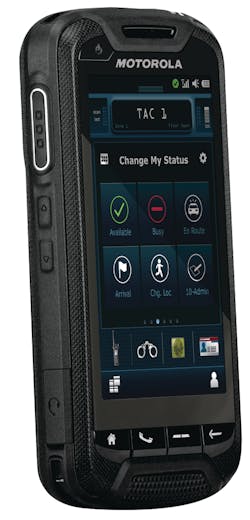In anticipation for the yet-to-come nationwide broadband network for first responders*, multinational telecom companies have been at work developing the first LE-only mobile phones that do a whole lot more than yesterday’s commercial offerings. (*In March, Congress passed D-Block spectrum legislation that finances the build-out of the broadband network.) Motorola and Thales have devices ready to go in the next year or so that will offer LTE compatibility and will communicate off the national broadband wireless network currently under construction (figuratively) by standards-creating governing bodies like the National Institute of Technology and The National Public Safety Telecommunications Council.
“We are advancing a completely new category of public safety multimedia devices that provide first responders with unprecedented access to powerful applications and always-on public safety broadband,” says Bob Schassler, senior vice president in Radio Solutions at Motorola.
The devices are similar in offerings, which include a handheld “phone” (though both companies are reluctant to use that terminology, as well as Motorola was not crazy about the idea of calling a such device as a “public safety super phone”) company-exclusive plans for core apps for each device (a camera/video app, for example) and the ability for developers to create apps for the platforms similar to how the Apple and Android markets currently operate.
Motorola Solutions’ LEX 700 Mission Critical Handheld delivers a compact, rugged form factor with intuitive user interface and access to multimedia applications.
Bob Andreas, with Thales USA Defense & Security, explains the company’s handheld device will also offer PTT and other features integrated into a Long Term Evolution solution to accompany the national broadband network currently underway for U.S. public safety. Andreas, who has a background in aerospace and security communications, says Thales’ solution will include a network management system using the LTE core broadband network, a push-to-talk smartphone device operating on the LTE network and applications that support first responders in the field.
Both the Thales device and Motorola’s LEX 700 were unveiled at the International Wireless Communications Expo in Las Vegas this February. Take a look at the features in store for the future of LE mobile communications.
Motorola’s LEX 700 device
The 1 Ghz dual-core processor LEX 700 has the advantage of building off Motorola’s commercial-grade success. The new handheld mobile phone with a 4-inch touchscreen looks as though it could be a phone new to the consumer market, giving it a slightly covert appearance. When you get a hands-on look, however, there are features built into the LEX meant to deliver specifically to the law enforcement mission.
The phone has four stationary buttons at the bottom of its face and a touchscreen interface that navigates similar to popular smartphones, like the iPhone or Samsung Galaxy S II, with screens displaying widgets such as a weather app and other core apps like a real-time video intelligence application that provides a shared operational view of an incident with high-quality, real-time video pulled from fixed and mobile cameras or streamed to the field from the command center. Ryan Seick, a product manager for the LEX 700 Mission Critical Handheld device at Motorola Solutions, explains several features:
Wise design: The buttons and jacks around the perimeter of the device itself were designed considering the user, such as the push-to-talk button, volume keys and headset jack on the left side of the unit.
“When I push the PTT button, there’s no opposing buttons on the opposite side, so I won’t inadvertently change when I really want to talk to somebody [unlike] some consumer-grade devices,” Seick says. “Also, everything’s on one side, so if I’m sitting there with [it in]the holster, my headset jack and everything is at one side of the device, so it’s not wrapping around or getting caught up from the device as well.”
Forward-firing speaker: Another element of the LEX that was adapted from commercial devices to better suit LE.
“Consumer-grade devices have the speakers in the back and in this environment, you’ve got to hear what people are talking about, so you can’t have the audio muffled" by a hand holding the device and the palm obscuring the sound originating from the back.
Take high-quality pics and video, adaptable for biometric readers, etc.: “On the back we’ve got an 8 mega-pixel camera. It also works as a camcorder too, so it’ll capture DVD-quality video,” Seick explains. “[There’s also a] high-output LED flash for low-light performance. We have attach points directly on the product on the top and bottom, so if I were to have an accessory, like a biometric reader, a fingerprint reader [or a] magstrip reader, I have the ability to attach it directly to the device, provide power and data to the application."
Motorola has developed a handful of its own apps for law enforcement and plans to allow developers the opportunity to build applications for the law enforcement market, which will be available in an app distribution platform similar to (but separate from) the Apple App Store. Two battery options include a shift-length battery or shift and a half (8-10 hours or 12-14).
The Thales solution
Thales’s LTE solution is also about the same size as the consumer-grade devices many law enforcement are using today. The Android PTT smartphone is planned to have a large touchscreen interface and fixed home buttons at the bottom of the unit, similar to the LEX.
The company says the complete offering consists of a comprehensive network management system using the LTE core broadband network, a push-to-talk smartphone device operating on the LTE network and applications that support first responders in the field. That means that in addition to its LTE compatibility, the phone will be able to use 3G networks to communicate, which would require only the SIM card allowing access supplied by the service provider such as Verizon, AT&T, etc., (chosen by the agency).
Brad Foreman, leading the Thales team in the LTE public safety division with 30 years experience total in communications for commercial and aerospace sectors, explains the Thales device mimics features from consumer smartphones, like the screen size (approximately 4.5 inches with plans to offer a possible 7- or 10.5-inch tablet-size device as well) and touchscreen interface, but is more ruggedized and beefed up to withstand law enforcement needs. That’s Bluetooth, Wi-Fi, 3G and PTT capabilities all in one device.
In corporate documents, Thales explains its LTE distributed architecture allows dispatchers to successfully communicate messages between several interconnected base stations, towers and first responders even if one of the base stations or towers is out of service. The network architecture is meant to provide users with security and flexibility by taking away the risk of a single point of failure in the system.
Thales is also developing apps for its phone, with Foreman saying there are about 10-12 core apps in progress with the intention to allow developers to create apps for its users as well. One of Thales’ apps, Foreman says, is a GPS-enabled system that can show LE commanders and officers the location of other officers in a given area.
Those elective apps, which will be accessed through a Thales “App Store”-like platform, will be available to users but controllable by agency supervisor.
The handheld device will provide comprehensive voice, data and video recording and a streaming package, which allows users to share critical information in real-time to their teams in the field and to report images and video that address situational awareness.
Without giving too much away on pricing, Foreman and Andreas say the devices will cost more than commercial smartphones but less than a P25 radio. Two elements that will likely keep public safety super phones more costly than commercial-grade devices is that the production volume will never be to the scale of 3G phones in the consumer market, just based on the finite number of end-users for a public safety-only device, and the ruggedized nature of a device built to do what it took many devices to do prior.
Thales will be submitting its handheld device and equipment for review and certification this fall and plans to have equipment available next year.
The future of smartphones for cops
With two large companies investing significant time, development and resources into a phone purpose-built for LE, there are sure to be other companies to follow. What the law enforcement—and public safety network in general—offer police that commercial carriers cannot is the ruggedized equipment built to public safety standards, as well as the security and compatibility with the as-yet-to-be launched public safety broadband networks.
Check out a video walk-through of the LEX 700 in the LET July iPad edition! Search “Law Enforcement Technology” in the App Store and subscribe free!
About the Author

Tabatha Wethal
Editor
Award-winning writer Tabatha Wethal is a previous editor leading Law Enforcement Technology magazine and assisted with other publications. She was with the magazines since 2007.
